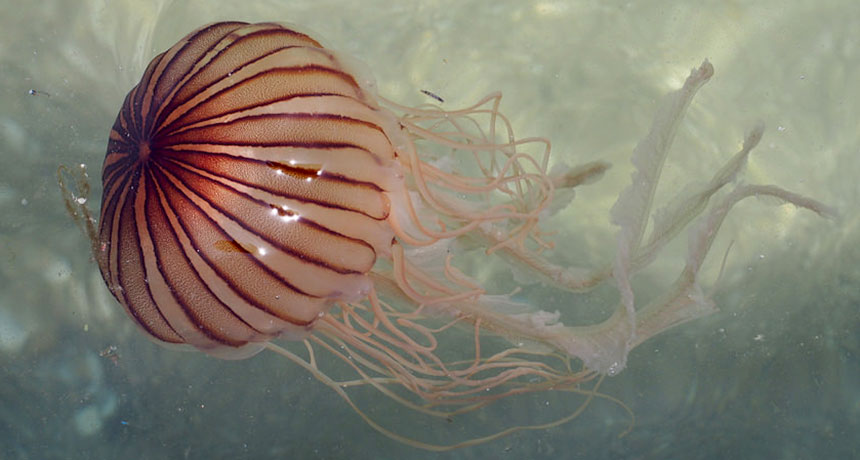Some jellyfish sting deeper than others

The moderate sting from this Chrysaora pacifica jellyfish comes from a small number of stinging nematocysts that are long enough to penetrate the skin of its prey (or an accidental victim). More painful species have longer stingers and more of them, a new study finds.
harum.koh/Flickr (CC-BY-SA 2.0)
- More than 2 years ago
Jellyfish are best avoided, in my opinion. Though beautiful to watch in an aquarium, jellies are equipped with stingers that can be harmless — or cause pain or even kill. And it can be difficult to tell the difference without some research — which you don’t really have time for when one is heading for your leg.
When the tentacle of a jellyfish makes contact with another animal, stinging nematocysts discharge a tiny tubule that injects venom into the victim — an action that takes place in a mere three milliseconds. How painful the sting can be depends on a few factors, including the type of venom the jelly produces and how long its arms are, which affects how many stingers make contact with the victim.
Ryuji Kitanani and colleagues at the Tokyo University of Marine Science and Technology thought that tubule length might also contribute to how much pain a jellyfish could produce. The nerve cells that are responsible for telling us that we’re in pain sit about 100 to 200 micrometers beneath the skin. So they figured that harmful species of jellyfish should have more tubules that are longer than 200 micrometers than harmless species. They tested their hypothesis on four species of jellyfish found in Japanese waters:
- Aurelia aurita: commonly found in shore areas, so people frequently encounter them but rarely report stings;
- Chrysaora pacifica: considered moderately harmful because its stings are moderately painful;
- Carybdea brevipedalia: found in coastal areas and causes severe pain and leaves red marks where tentacles touch;
- Chironex yamaguchii: causes acute pain, muscle spasms and, in some cases, death.
The researchers collected jellyfish from the wild, isolated nematocysts and measured the tubules. They report their findings August 26 in PLOS ONE.
“Harmful species tended to have longer tubules,” the team found. The tubules of the harmless A. aurita were mostly smaller than 100 micrometers and none reached the 200-micrometer threshold. C. pacifica had an average tubule length of 117 micrometers, but 6 percent were more than 200 micrometers. That may explain why this species can produce a bit of pain.
The tubules of C. yamaguchii, the deadly species, were 334 micrometers on average, and most were more than 200 micrometers in length. Some were more than 500 micrometers long. C. brevipedalia, though, took the record for longest tubule, at 1524.5 micrometers at its maximum. Its tubules were also the longest on average — 712 micrometers. That explains why these two species produce a sting that is so much more painful than the other two, the researchers say — the deeper the sting, the more painful it is.
But why is C. yamaguchii more dangerous than C. brevipedalia? C. yamaguchii has shorter stingers, and studies have shown that its venom is less toxic. But this species, Kitanani and colleagues note, has tentacles three times as long as C. brevipedalia. That can result in more nematocysts coming into contact with the skin, resulting in more venom being injected.







